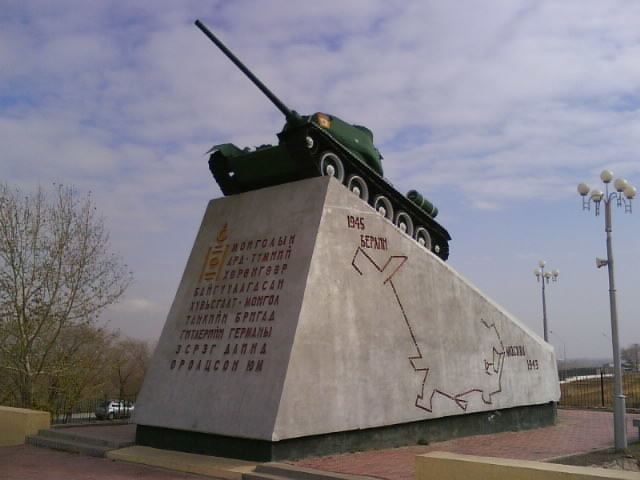Active 1941–present | Type Armored | |
 | ||
The 112th "Revolutionary Mongolia" Tank Brigade (Russian: 112-я танковая бригада «Революционная Монголия», 112-ya tankovaya brigade "Revolutsionnaya Mongoliya"), previously the 112th Tank Brigade, was a military formation in the Red Army, funded by contributions from the People's Republic of Mongolia, during World War II. It was originally formed as the 112th Tank Division.
Contents
112th Tank Division
The 112th Tank Division was formed in August 1941, in Primorsky Krai on the basis of 112th Tank Regiment, 239th Motorised Division, 30th Mechanised Corps, and the two brigades that gained fame in the battles on Lake Khasan and Khalkin-Gol.
The forming of the division was entrusted to Colonel Andrei Getman, the former chief of staff of the 30th Mechanised Corps. Deputy Colonel Andrei Getman appointed Plato Y. Mikhailov, a division of profits experienced commanders: The division commissioner became regimental commissar Yefim V. Beznosov, to the post of chief of staff appointed Colonel Mikhail Leonov Trofymovych.
By mid-October 1941, the 112th Tank Division was ready to be sent to the front. On the morning of November 4, on the railway between Ryazan and Moscow, the train carrying the division headquarters were bombarded by German planes. Four soldiers were wounded and two were killed. On November 7, over two dozen trains of the division were unloaded at Podolsk station.
The 112th Division became part of the 6th Tank Corps, 1st Tank Army. Western Front headquarters created a mobile mechanized cavalry group, composed of General Belov's cavalry corps and the 112th Tank Division, the whole commanded General Alexander Belov. The group was created to stop the enemy taking Tula. On the orders of Joseph Stalin from the Serpukhov district with right-flank connections 16th Army of General Rokossovsky, 112th Tank Division was directed to strike at the flank of the German 4th Army, to make a decisive impact on Moscow.
The fighting near Moscow
The combat baptism of the division and its commander was November 16, 1941. The group together with other troops took the offensive in the direction of Maleev – Vyazovka – Vysokinichi, but, against strong resistance, failed to achieve substantial results. Within days, the division fought west and north-west of Serpukhov.
The 124th Tank Regiment, commanded by Colonel Menchov, was first to receive a baptism of fire in the battles near Tula. In defensive battles near Tula the 112th Tank Division struck the enemy counter-attack, and then went on the offensive, covering the road Serpukhov – Tula, Division entered the line Shepilova – Zelezny .
As a result, General Belov's mobile group released seven localities and thwarted the attack by the German XIII Corps and held Serpukhov. After these battles, Colonel Getman's division was urgently transferred to Kashira, where the hospitals and the front of rear services, to eliminate the German breakthrough.
In connection with a breakthrough of the Soviet defensive line near Tula by Guderian's 2nd Panzer Group, General Ivan Boldin's 50th Army was transferred to the defense and Kashira plant. Until the beginning of the counter-offensive, 112th TD served as a fire brigade, conducting counter-attacks on the flanks of groups of the enemy, supporting 49th and 50th Armies' thin line of defence.
For its performance in military operations, 112th Tank Division received the Order of the Red Banner. On January 2, 1942 the division was reorganised as the 112th Tank Brigade, maintaining its numbers and numbers of regiments, which became battalions.
1943
The unit received the "Revolutionary Mongolia" title in 1943 when it was re-equipped with 34 T-34/76 and 21 T-70 tanks funded by the Mongolian government of Gonchigiin Bumtsend. The Mongolian tanks were presented on 17 January 1943. In addition the Mongolian delegation, headed by Marshal H. Choibalsan, handed over gratis 237 railway wagons with clothes and food: 1,000 tons of meat, 90 tons of oil, 80 tons of sausages, 150 tons of confectionery, 30,000 coats, 30,000 pairs of boots, and 30,000 fur padded jackets. One tank was presented by Marshal Choibalsan personally.
The brigade initially formed part of the 6th Tank Corps (I Formation). Subsequently, with the title "Revolutionary Mongolia" in the brigade received T-34 tanks of more advanced types.
The success of the unit was later followed by the creation of the Mongolian Arat squadron in the Soviet Air Force. Its commander, I. I. Gusakovii, was a double Hero of the Soviet Union.
In 1964, the unit was awarded the Order of Damdin Sükhbaatar by the Mongolian government. The Zaisan Memorial, featuring a surviving T-34 tank, was erected in 2003 to commemorate the role of the brigade.
It later became the 44th Guards Tank Brigade, then after the war the 44th Guards Tank Regiment. In 1993, it became the 44th Guards Tank Training Regiment, part of the 467th Guards District Training Centre.
